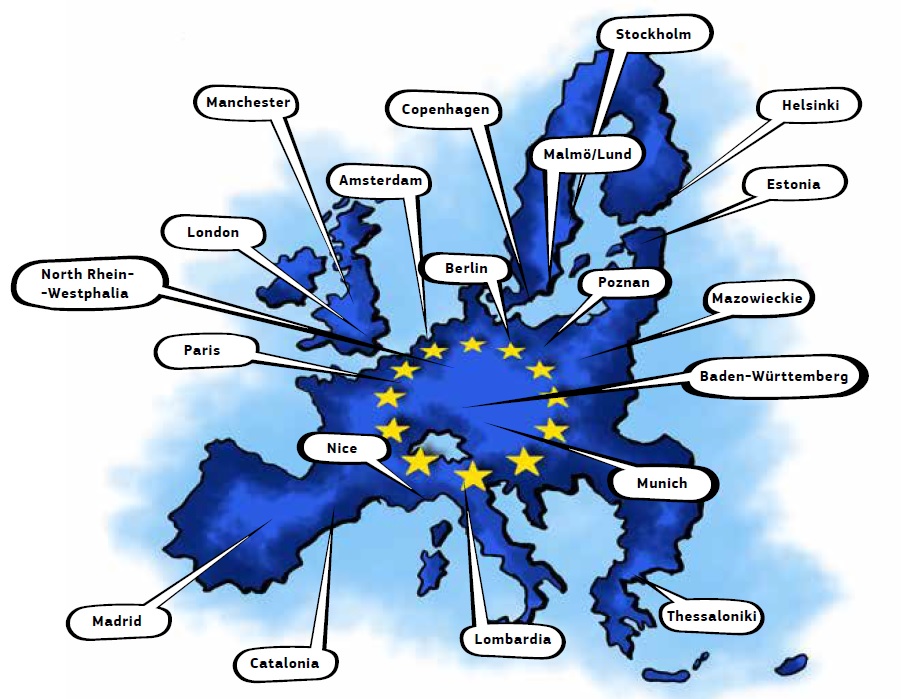Finding the hot spots of Europe
 PREVIOUS CHAPTER PREVIOUS CHAPTER |
BACK TO CONTENT | NEXT CHAPTER .png) |
FINDING THE HOT SPOTS OF EUROPE
PARIS
|
Access to knowledge and talent
Are there universities in the region with a reputation for delivering relevant courses and supporting quality research, and does the region have the right “profile” to attract talent from other parts of the world?
|
General Impression
What is the first impression of the region and what is it known for?
|
Growth of start ups
How many new companies within the field of mobile started during 2012, and how is the start-up scene emerging?
|
||||||||
|
Market
What is the strength and depth of the market? Is it quick to adopt new technologies?
|
 |
Cluster strength
Is the cluster strong and what supporting structures are in place?
|
||||||||
|
Financial tools
Are there SME instruments and financial support (both public and private) available?
|
Informal structures
In what ways is the cluster ethos and influence communicated around the region
|
|||||||||
|
Formal support
What is the size and nature of publicly funded support such as incubators, development centres etc.?
|
||||||||||
|
Industrial history
Does the region have a history in the mobile industry with presence of well-known brands?
|
Important events
Does the region attract important events for the industry such as the Mobile World Congress, or Web Summit?
|
|||||||||
THE 20 HOTSPOTS
The indicators gave us knowledge about how to compare regions with each other. As a result, we were able to select twenty examples of European hotspots that provided an excellent environment in one or more of the indicators for start-ups in the field of mobile technology and services.
The list is not ranked, and the selection of twenty hotspots was made to show diversity and to gather knowledge about the drivers behind regional growth in an emerging industry. It was felt that twenty regions would provide a wide enough knowledge base, and still be manageable. Therefore, it is important to stress that the description of “excellent” could be applied to other regions not appearing on the list, and the inclusion of a region is not necessarily an indication that it is the best place for any individual to start a mobile company.

DIGGING DEEPER
|
In order to find out more about the drivers behind excellence, and go beyond pure data analysis, five regions were chosen for a more in-depth study of their regional innovation systems. To give the broadest possible view, they were chosen to ensure a diversity of size, level of public policies, historical background and geographical location.
The methodology used for this study was to carry out in-depth interviews with relevant people across the region. In total 106 interviews were conducted across the five regions. The interviewees included people from the public sector, venture capital companies, start-ups, multinationals, incubators and universities. The interviews gave an insight into how the start-up scene is evolving, and what critical factors are involved in creating growth in the mobile sector.
|
|
The start-up community within the mobile sector has been growing rapidly over the past few years. It is now regarded as one of the most interesting start-up communities in Europe.
Even though there are some great challenges for the city, Berlin is seen as a strong brand; therefore it is able to attract entrepreneurs and competences from all over the world. Salaries are low, which benefits companies, and the cost of living is low, which benefits workers. This is facilitated by having some of the most open immigration policies in Europe. Berlin possesses a young and creative population, with a “can do” attitude providing an inspirational and creative touch in the city. The international scene in Berlin means that the spoken language is invariably English, even though the official language is German. A major difficulty for the region is that the local home market is too weak to sustain the growth of the industry. This weakens the ability of companies to carry out R&D, leading to a limit on long-term growth of both the companies themselves, and the region in general. Therefore, even though the city is “cool” and has a large
number of start-ups, not many companies have succeeded in the long term. Most companies start up and then either move on or die out. So, despite the ease with which companies can start-up in Berlin, keeping them alive and growing could become a problem. |
 |
BARCELONA - MOBILE WORLD CAPITAL?!
 |
The city of Barcelona and region of Catalonia, have arguably the most well-defined public policies in Europe when it comes to mobile services. This has paid off by producing a vibrant community of start-ups. Many of these were drawn to the city because it is the host of the annual Mobile World Congress. Clear strengths are that it is easy to start a company, talent is cheap, there are top universities to collaborate with and there is a strong commitment from those who have already succeeded to help others. The favourable climate and the city itself are also attractions. On the weak side, we see a language barrier to international communication, the policies are directed more towards local companies, and most of the companies that have developed tend to be family owned and they lack ambition to become international. In that sense the public policies and incentives have failed. |
ESTONIA: EUROPEAN MOBILE INDUSTRY START-UP TIGER
|
Estonia has a clear national agenda when it comes to the development of the mobile sector. It was one of the first countries to introduce a host of public mobile services that range from parking to voting. Strengths are: the high level of adoption of ICT within the public sector, a very good reputation, and that it is a small country which enables easier implementation of national policies, driving good integration of local businesses into global innovation networks. On the weak side, we see that the early growth is not sustainable as the industry in Estonia has failed to reach critical mass.
There is a decreasing population through migration, especially of graduates, exacerbating the shortage of qualified ICT professionals. In addition, there is a low level of R&D nationally as a result of the small number of universities that are able to support research in the area. |
 |
LONDON: INNOVATION GROWTH IN ROUNDABOUT WAY
|
The rapid growth of London’s mobile services start-up
community (the fastest growth in Europe) has led to the epicentre of the cluster in Shoreditch being dubbed “Silicon Roundabout”. Growth has been assisted by the clear business focus of the city. The city’s clear strengths are the innovation climate, the multi-cultural environment, excellent access to capital, a critical mass in start-ups and very good infrastructure. On the other hand, it is held back by the lack of collaboration with traditional R&D, the lack of large multinational companies within the mobile sector based in the city and the economic isolation of London from the rest of the UK. |
 |
MALMÓ/LUND: ONE REGION, TWO WORLDS
 |
The story behind the Malmö/Lund area starts with two things: the invention of Bluetooth Technology in Lund and the change from a traditional heavy industry city to a knowledge industry city in Malmö. Even though the area only consists of about 400,000 inhabitants, it hosts multinational companies like Sony, Microsoft, Ericsson, Huawei, Samsung and Intel. The long history within mobile is one of the region’s strengths, together with more recent success stories, excellent infrastructure, leading universities, multinational companies and strong collaboration within the region. Conversely, the region suffers from a lack of capital, a weaker international reputation, not enough commercial thinking, a small home market (which also can be an advantage in some cases) and a low acceptance of failure.
|






